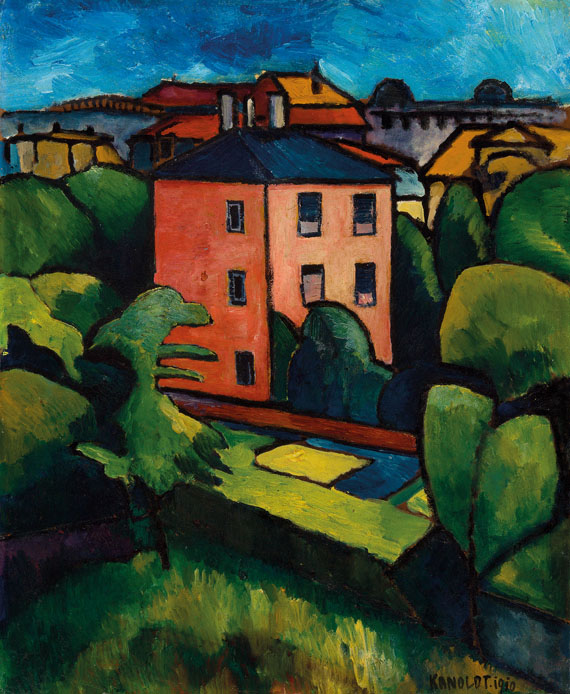
(incl. surcharge)
Das rote Haus. 1910.
“Throughout Kanoldt’s production, his objective style is the crucial aspect. Behind this objectivity, which might almost be called philosophical, a strong individuality and a new love for form as they could only develop into a style within certain trends at particular times in our technological age. [...] The intense stringency of the draughtsmanly form is echoed in the palette. This highly musical consonance is what gives his pictures the character of such completeness. On occasion, one stands awe-struck, shattered, before these still lifes and vedute, which, through the obsession born of creativity, have extracted to the utmost the formal content of things.” (Alfred Mayer, quoted in: Alexander Kanoldt 1881-1939. Gemälde, Zeichnungen, Lithographien, Exhib. cat. Museum für Neue Kunst, Freiburg i.Br./Von-der-Heydt-Museum, Wuppertal 1987, p. 212).
In 1913 Kanoldt, as well as Karl Caspar, Alexej von Jawlensky and Paul Klee, was a member of the "Münchener Neue Sezession". Kanoldt's artistic career was interrupted by the outbreak of the war. In 1924 Kanoldt produced multi-perspective architectural landscapes and serene interiors. These works mark a new beginning in Kanoldt's work and result in an invitation to exhibit works in the "Neue Sachlichkeit" exhibition in 1925 at the Kunsthalle Mannheim. Together with Karl Hofer Kanoldt was founder of the 'Badische Secession' in Freiburg in 1927, in 1931 he opened a private painting school in Garmisch-Patenkirchen. In 1932 he joined the Munich artist group "Die Sieben". His works were labelled "degenerate" during the Nazi regime and confiscated in 1937. Alexander Kanoldt died of a heart disease on 24 January 1939. [NB]
PROVENIENZ: Vorge Hansen-Moller, Pasadena/California (since the 1930s).
Oil on cardboard with canvas structure, firmly mounted on fibreboard at points on the reverse.
Signed and dated lower right. 61,2 : 51,1 cm (24 : 20,1 in). Alexander Kanoldt was born in Karlsruhe on 29 September 1881 as the son of the landscape painter Edmund Friedrich Kanoldt. He began an apprenticeship as a decorative painter at the local Kunstgewerbeschule at the age of eighteen, but decided to join the Academy in 1901. He took drawing lessons with Ernst Schurth and became acquainted with Adolf Erbslöh. During this time Kanoldt closely studied Neo-Impressionist techniques, which inspired his technically extremely sophisticated colour lithographs. In 1904 Kanoldt continued his studies Friedrich Fehr's painter's class and became his master pupil between 1906 and 1909. Kanoldt moved to Munich in 1908, where he founded the 'Neue Künstlervereinigung', a forerunner of the 'Blauer Reiter', together with Alexej von Jawlensky, Wassily Kandinsky, Gabriele Münter and others one year later. Kanoldt also took part in their first exhibition at Heinrich Thannhauser's Moderne Galerie in Munich in 1909.
Private ownership (acquired from the previous owner in 2007).
Private collection Switzerland.
AUSSTELLUNG: Neue Künstlervereinigung München, Moderne Galerie Thannhauser, Munich 1910, no. 66.
Wanderausstellung Neue Künstlervereinigung München, Galerie Paul Cassirer, Berlin 1911, no. 36.
The work is recorded in the artist's personal work list from 1910 (no. 28)
In good condition, colours still fresh. Lower centre margin with small disruption/tear (ca. 1cm). Outermost margins with nail or pin holes. Edges barely noticeably rubbed. Barely noticeable craquelé, at points with barely noticeable colour loss. Isolated retouchings, mainly on the margins, on the part of the house, the adjacent tree, there also with a small damage of the uppermost paper layer as well as on the sky. Probably freshly varnished.
(incl. surcharge)
Headquarters
Joseph-Wild-Str. 18
81829 Munich
Phone: +49 89 55 244-0
Fax: +49 89 55 244-177
info@kettererkunst.de
Louisa von Saucken / Undine Schleifer
Holstenwall 5
20355 Hamburg
Phone: +49 40 37 49 61-0
Fax: +49 40 37 49 61-66
infohamburg@kettererkunst.de
Dr. Simone Wiechers / Nane Schlage
Fasanenstr. 70
10719 Berlin
Phone: +49 30 88 67 53-63
Fax: +49 30 88 67 56-43
infoberlin@kettererkunst.de
Cordula Lichtenberg
Gertrudenstraße 24-28
50667 Cologne
Phone: +49 221 510 908-15
infokoeln@kettererkunst.de
Hessen
Rhineland-Palatinate
Miriam Heß
Phone: +49 62 21 58 80-038
Fax: +49 62 21 58 80-595
infoheidelberg@kettererkunst.de
We will inform you in time.




 Lot 221.10
Lot 221.10 